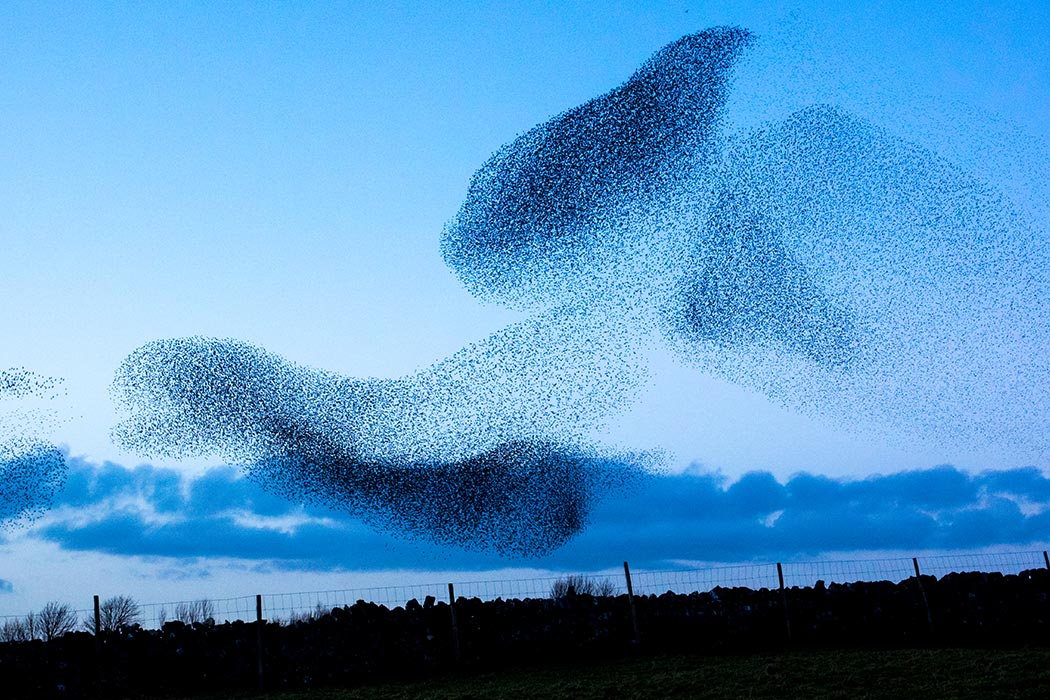The story goes something like this: Once upon a time, a man decided it would be nice if all the birds mentioned in Shakespeare lived in Central Park. He let loose flocks of nightingales, but it didn’t work. He freed skylarks, but they quickly died in the harsh New York winters. Then one day he sent a cageful of house sparrows out into the park… and they stayed. Emboldened, he brought sixty European starlings. They survived that winter, and the next, and then they began to multiply. Within fifty years, they had covered the entire continent. Within a century, they numbered 200 million.
It wasn’t long after I first started working with birds that I first heard the story of Shakespeare’s unexpected role in promoting species invasions in North America. Most birders could probably tell you a similar version. It’s become part of birding’s folklore, the set of stories that enthusiasts use as currency to prove their membership in the group. But is it true? Who was this Shakespeare-obsessed New Yorker, and was he really responsible for introducing the two most invasive bird species on the continent?
The answer, as with most folklore, is yes and no.
* * *
It’s normally difficult to pin down the moment when an invasive species first arrives. Invasions are usually operations of ninja-like stealth: a plant seed hitchhikes between continents on an unwashed shoe, or an exotic mussel sneaks into a new lake clinging to the hull of a ship. By the time someone notices the invaders, it’s too late, and what began as a stealth operation has already become a hostile takeover. Native species are out-competed or out-consumed, economically important resources are damaged, and millions of dollars are spent to keep the invading forces in check.
Every now and then, though, it’s possible to pinpoint the exact start date. For the European starling in North America, that date is March 6, 1890, when a man named Eugene Schieffelin let loose a fateful cageful of birds in Central Park. He was a pharmacist and nature enthusiast who left little trace of himself. There are accounts from the New York Zoological Society, of which he was a member, and the American Acclimitization Society (more about them in a moment). Schieffelin’s introduction of starlings wasn’t the first attempt—others had previously tried and failed—but it was the first to work.
His role in the introduction of the house sparrow, which took place thirty years earlier, in 1860, is a bit murkier. Schieffelin did attempt an introduction of house sparrows, but his was one of many such attempts around the same time, so there’s no way to place the blame directly on him.
As for the Shakespeare part of the story, the reality may be less poetic. Schieffelin was indeed a Shakespeare enthusiast, but accounts published at the time of the release focus on the practical and aesthetic values of the introduced species without mentioning their literary merits (“birds which were useful to the farmer and contributed to the beauty of the groves and fields”). It’s possible that a love of Shakespeare was secondary to concerns of insect control and, more broadly, establishing populations of beneficial exotic species in new environments. Schieffelin’s American Acclimatization Society was part of a larger movement, which originated in Europe, seeking to harness the world’s biological resources without regard for geographical boundaries. By studying species’ responses to novel environments, scientists and enthusiasts hoped to figure out how to transplant beneficial species from around the world to their own backyards.
Lest you imagine we now know better, this concept isn’t substantially different from present-day biological controls: Novel species are still deliberately introduced to solve particular problems as part of natural-resource-management strategies. Although they have the potential to be useful if carefully deployed, “biocontrol” introductions also have a history of turning into Old Lady Who Swallowed a Fly scenarios, in which an escalating series of introductions is required to control the controls. In the Florida Everglades, where the invasive melaleuca tree was introduced in an attempt to dry out wetland areas for construction, we now employ teams full-time to travel around cutting back trees. Cane toads, introduced to control invasive beetles in Australian sugar cane crops, have rapidly displaced native amphibians and poisoned local predators. To make matters worse, biologists later realized that the toad couldn’t jump high enough to prey on the beetles it was meant to target. Each mistake has been a learning experience, albeit an irreversible one.
It’s hard to say if starlings actually provide better insect control than native species, but their unintended side effects, from displacing native species in nesting cavities to causing deadly plane crashes, are readily apparent. Meanwhile, in an ironic turn of events, house sparrows are now in decline in England, their—and Shakespeare’s—homeland. The introduced North American population may turn out to be an unintended stronghold for the species.
Birding folklore simplifies a complex story by focusing blame on Eugene Schieffelin—painting him as a misguided romantic with a lot to answer for (if not an outright villain). However, this story ignores the reality that prevailing scientific attitudes, like the Victorian obsession with acclimatization, can later turn out to be spectacularly misguided. The damage inflicted by one man with a Shakespeare fetish is nothing compared to the destructive potential of a large group of humans armed with an inflated sense of their ability to control the natural world. Although we’re now slightly more cautious about moving species around the globe, we still don’t have a foolproof way of predicting whether species will become nuisance invaders or what their effects will be on native wildlife.
Perhaps the story of Eugene Schieffelin isn’t about Shakespeare at all; perhaps it’s a cautionary tale about the hubris of manipulating the natural world without fully understanding it. Or, as Shakespeare pointed out: “The fool doth think he is wise, but the wise man knows himself to be a fool.”







